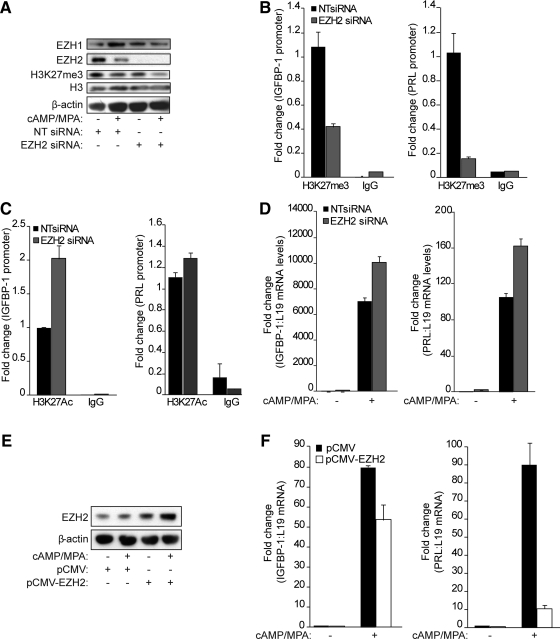Fig. 5.
EZH2 down-regulation is permissive for the induction of decidual marker genes. A, Total cell lysates from primary HESC cultures first transfected with either NTor EZH2 siRNA and then treated with cAMP and MPA for 2 d were subjected to Western blot analysis and probed with EZH1-, EZH2-, H3K27me3-, and H3-specific antibodies. β-Actin served as a loading control. B, ChIP with H3K27me3 and IgG antibodies was performed on cultures treated as above. The precipitated DNA fragments were analyzed by qPCR and normalized to the input. The primers used were specific for the proximal promoter regions of IGFBP1 (left panel) and PRL (right panel). Data are expressed as the fold change (±sem of triplicate measurements) relatively to the abundance of chromatin-bound H3K27me3 in untreated cells. C, ChIP was carried out with H3K27ac-specific antibody under the experimental conditions described above. D, PRL and IGFBP-1 transcript levels were measured by RT-qPCR in HESC first transfected with either NT or EZH2 siRNA and then treated with cAMP and MPA for 2 d. The data show fold-change (±sem of triplicate measurements) in expression relative to untreated cells transfected with NT siRNA. E, Protein lysates extracted from cells first transfected with an empty control vector (pCMV) or a plasmid encoding EZH2 (pCMV-EZH2) vector and then treated with decidualization stimuli for 2 d were subjected to Western blot analysis and immunoprobed for EZH2. β-Actin was used as a loading control. F, Total RNA from parallel cultures was examined for the expression of IGFBP-1 (left panel) and PRL (right panel) transcripts by RT-qPCR. The data (mean ± sem) are presented as fold induction, and the results are representative of three repeat experiments.

